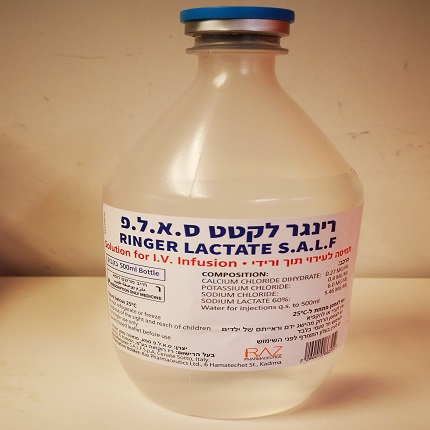Quest for the right Drug

רינגר לקטט ס.א.ל.פ RINGER LACTATE S.A.L.F (CALCIUM CHLORIDE DIHYDRATE, POTASSIUM CHLORIDE, SODIUM CHLORIDE, SODIUM LACTATE)
תרופה במרשם
תרופה בסל
נרקוטיקה
ציטוטוקסיקה
צורת מתן:
תוך-ורידי : I.V
צורת מינון:
תמיסה לאינפוזיה : SOLUTION FOR INFUSION
עלון לרופא
מינוניםPosology התוויות
Indications תופעות לוואי
Adverse reactions התוויות נגד
Contraindications אינטראקציות
Interactions מינון יתר
Overdose הריון/הנקה
Pregnancy & Lactation אוכלוסיות מיוחדות
Special populations תכונות פרמקולוגיות
Pharmacological properties מידע רוקחי
Pharmaceutical particulars אזהרת שימוש
Special Warning עלון לרופא
Physicians Leaflet
Posology : מינונים
4.2. Posology and method of administration • Clinically relevant electrolyte disturbances and Posology acid-base imbalance. Adults, the elderly and children: Clinical evaluation and periodic laboratory determinations may be necessary to monitor The dosage depends on the age, weight, clinical changes in fluid balance, electrolyte concentrations and biological (acid-base balance) conditions of and acid-base balance during prolonged parenteral the patient, and concomitant therapy. therapy or whenever the condition of the patient or the rate of administration warrants such evaluation. Recommended dosage: High volume infusion must be used under specific The amount of Ringer Lactate S.A.L.F. needed to monitoring in patients with cardiac or restore normal blood volume is 3 to 5 times the pulmonary failure and in patients with non-osmotic volume of lost blood. vasopressin release (including SIADH), due to the risk of hospital-acquired hyponatraemia (see below). The recommended dosage is: For adults: 500 ml to 3L/24h. Hyponatraemia For babies and children: 20 ml to 100 ml / kg / 24h. Patients with non-osmotic vasopressin release (e.g. in acute illness, pain, post-operative stress, Administration rate: infections, burns, and CNS diseases), patients with The infusion rate is usually 40 ml/kg/24h in adults. heart, liver or kidney diseases and patients exposed In paediatric patients, the infusion rate is 5 ml/kg/h to vasopressin agonists (see section 4.5) are at on average but the value varies with age: 6-8 ml/kg/h particular risk of acute hyponatraemia upon infusion for infants, 4-6 ml/kg/h for toddlers, and 2-4 ml/kg/h of hypotonic fluids. for schoolchildren. In children with burns, the dose is on average 3.4 ml/kg/percent burn at 24 h post- Acute hyponatraemia can lead to acute burn and 6.3 mL/kg/percent burn at 48 h. In severely hyponatraemic encephalopathy (cerebral oedema) head-injured children, the dose is on average characterized by headache, nausea, seizures, 2850 ml/m². lethargy and vomiting. Patients with cerebral oedema Infusion rate and total volume can be higher in are at particular risk of severe, irreversible and life- surgery or in case of need. threatening brain injury. Note: Children, women in the fertile age and patients - Infants and toddlers: age ranges from about 28 with reduced cerebral compliance (e.g. meningitis, days to 23 months (a toddler is an infant who can intracranial bleeding, cerebral contusion and brain walk). oedema) are at particular risk of the severe and - Children and school children: age ranges from life-threatening brain swelling caused by acute about 2 years to 11 years. hyponatraemia. Administration: Use in patients with hypervolaemia, overhydration or The administration is performed by intravenous route conditions causing sodium retention and oedema using sterile and non-pyrogenic equipment. Ringer Lactate S.A.L.F. should be administered with particular caution to hypervolaemic or overhydrated

שימוש לפי פנקס קופ''ח כללית 1994
לא צוין
תאריך הכללה מקורי בסל
01/01/1995
הגבלות
תרופה מוגבלת לשימוש בבתי חולים או אשפוז יום
מידע נוסף
